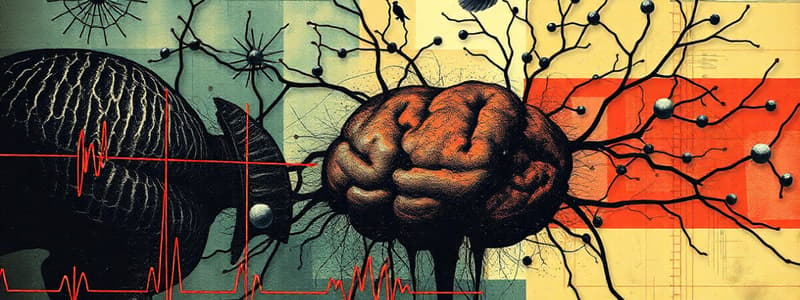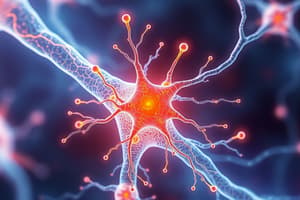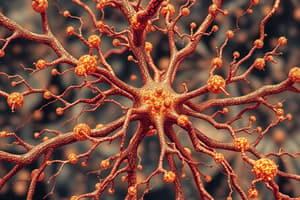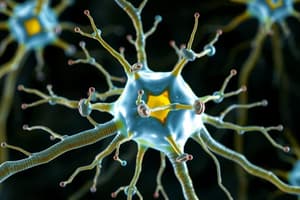Podcast
Questions and Answers
Which neuropeptide is primarily responsible for stimulating thirst and regulating blood pressure?
Which neuropeptide is primarily responsible for stimulating thirst and regulating blood pressure?
- Angiotensin II (correct)
- Hypothalamic releasing hormones
- Cholecystokinin
- Neuropeptide Y
Neurons in the central nervous system have a high capacity to regenerate themselves.
Neurons in the central nervous system have a high capacity to regenerate themselves.
False (B)
What is the main function of neuropeptide Y?
What is the main function of neuropeptide Y?
Stimulates food intake
The process of the nervous system changing based on experience is called _______.
The process of the nervous system changing based on experience is called _______.
Match the following types of neural circuits with their descriptions:
Match the following types of neural circuits with their descriptions:
What determines the amplitude of a graded potential?
What determines the amplitude of a graded potential?
Graded potentials can be added together to create larger potentials.
Graded potentials can be added together to create larger potentials.
Name the two phases of an action potential.
Name the two phases of an action potential.
Action potentials occur only if the membrane potential reaches ______.
Action potentials occur only if the membrane potential reaches ______.
Match the following characteristics to either Graded Potentials or Action Potentials:
Match the following characteristics to either Graded Potentials or Action Potentials:
What type of channels are primarily responsible for action potentials?
What type of channels are primarily responsible for action potentials?
Graded potentials can propagate over long distances.
Graded potentials can propagate over long distances.
What is the primary function of graded potentials?
What is the primary function of graded potentials?
Graded potentials use _______ or mechanically gated ion channels.
Graded potentials use _______ or mechanically gated ion channels.
Which type of neuron conveys information to the central nervous system (CNS)?
Which type of neuron conveys information to the central nervous system (CNS)?
Oligodendrocytes are responsible for producing myelin in the peripheral nervous system (PNS).
Oligodendrocytes are responsible for producing myelin in the peripheral nervous system (PNS).
What are the two types of neuroglia found in the peripheral nervous system?
What are the two types of neuroglia found in the peripheral nervous system?
The myelin sheath is produced by ________ in the CNS and ________ in the PNS.
The myelin sheath is produced by ________ in the CNS and ________ in the PNS.
Match the types of neuroglia to their functions:
Match the types of neuroglia to their functions:
How many total types of neuroglia are there?
How many total types of neuroglia are there?
Neuroglia are electrically excitable cells that make up about half the volume of the nervous system.
Neuroglia are electrically excitable cells that make up about half the volume of the nervous system.
What is the typical amplitude of an action potential?
What is the typical amplitude of an action potential?
Graded potentials can be hyperpolarizing.
Graded potentials can be hyperpolarizing.
What are the two primary phases of an action potential?
What are the two primary phases of an action potential?
Larger diameter axons propagate action potentials __________.
Larger diameter axons propagate action potentials __________.
Match the factors affecting action potential propagation with their effects:
Match the factors affecting action potential propagation with their effects:
Which of the following statements about action potentials is true?
Which of the following statements about action potentials is true?
Summation can occur during the refractory period of nerve impulses.
Summation can occur during the refractory period of nerve impulses.
Name one factor that increases the speed of action potential propagation.
Name one factor that increases the speed of action potential propagation.
The propagation of action potentials is also referred to as __________.
The propagation of action potentials is also referred to as __________.
What is the duration range for graded potentials?
What is the duration range for graded potentials?
Which type of summation occurs when multiple presynaptic end bulbs release their neurotransmitter simultaneously?
Which type of summation occurs when multiple presynaptic end bulbs release their neurotransmitter simultaneously?
Temporal summation involves neurotransmitter release at different times.
Temporal summation involves neurotransmitter release at different times.
Name one type of small molecule neurotransmitter.
Name one type of small molecule neurotransmitter.
Substance P is primarily involved in the perception of __________.
Substance P is primarily involved in the perception of __________.
Match the neuropeptides with their descriptions:
Match the neuropeptides with their descriptions:
Which neuropeptide is known for its role in inhibiting pain?
Which neuropeptide is known for its role in inhibiting pain?
Amino acids are classified as small molecule neurotransmitters.
Amino acids are classified as small molecule neurotransmitters.
What type of neurotransmitter is nitric oxide classified as?
What type of neurotransmitter is nitric oxide classified as?
Neurotransmitters such as __________ are responsible for transmitting signals across a synapse.
Neurotransmitters such as __________ are responsible for transmitting signals across a synapse.
Which of the following neuropeptides is NOT mentioned in the context provided?
Which of the following neuropeptides is NOT mentioned in the context provided?
Flashcards
Multipolar Neurons
Multipolar Neurons
Neurons with multiple processes extending from the cell body, including one axon and multiple dendrites.
Bipolar Neurons
Bipolar Neurons
Neurons with one main dendrite and one axon. These are found in the retina of the eye and olfactory epithelium.
Unipolar Neurons
Unipolar Neurons
Neurons with a single process extending from the cell body that branches into a dendrite and an axon. These are found in the sensory ganglia.
Sensory/Afferent Neurons
Sensory/Afferent Neurons
Signup and view all the flashcards
Motor/Efferent Neurons
Motor/Efferent Neurons
Signup and view all the flashcards
Interneurons/Association Neurons
Interneurons/Association Neurons
Signup and view all the flashcards
Neuroglia of the CNS
Neuroglia of the CNS
Signup and view all the flashcards
Graded Potential Amplitude
Graded Potential Amplitude
Signup and view all the flashcards
Graded Potential Summation
Graded Potential Summation
Signup and view all the flashcards
Action Potential
Action Potential
Signup and view all the flashcards
Depolarization
Depolarization
Signup and view all the flashcards
Repolarization
Repolarization
Signup and view all the flashcards
Action Potential Threshold
Action Potential Threshold
Signup and view all the flashcards
Action Potential: Na+ Channel Opening
Action Potential: Na+ Channel Opening
Signup and view all the flashcards
Action Potential: K+ Channel Opening
Action Potential: K+ Channel Opening
Signup and view all the flashcards
Graded vs. Action Potential: Conduction
Graded vs. Action Potential: Conduction
Signup and view all the flashcards
Hypothalamic Releasing and Inhibiting Hormones
Hypothalamic Releasing and Inhibiting Hormones
Signup and view all the flashcards
Angiotensin II
Angiotensin II
Signup and view all the flashcards
Cholecystokinin (CCK)
Cholecystokinin (CCK)
Signup and view all the flashcards
Neuropeptide Y
Neuropeptide Y
Signup and view all the flashcards
Neural Circuit
Neural Circuit
Signup and view all the flashcards
Graded potential
Graded potential
Signup and view all the flashcards
Propagation of action potentials
Propagation of action potentials
Signup and view all the flashcards
Continuous conduction
Continuous conduction
Signup and view all the flashcards
Saltatory conduction
Saltatory conduction
Signup and view all the flashcards
Axon diameter and conduction speed
Axon diameter and conduction speed
Signup and view all the flashcards
Myelination and conduction speed
Myelination and conduction speed
Signup and view all the flashcards
Temperature and conduction speed
Temperature and conduction speed
Signup and view all the flashcards
Synapse
Synapse
Signup and view all the flashcards
Signal transmission at synapses
Signal transmission at synapses
Signup and view all the flashcards
What is summation in neurotransmission?
What is summation in neurotransmission?
Signup and view all the flashcards
What is spatial summation?
What is spatial summation?
Signup and view all the flashcards
What is temporal summation?
What is temporal summation?
Signup and view all the flashcards
What is summation of postsynaptic potentials?
What is summation of postsynaptic potentials?
Signup and view all the flashcards
What are small molecule neurotransmitters?
What are small molecule neurotransmitters?
Signup and view all the flashcards
What is acetylcholine?
What is acetylcholine?
Signup and view all the flashcards
What are amino acid neurotransmitters?
What are amino acid neurotransmitters?
Signup and view all the flashcards
What are biogenic amine neurotransmitters?
What are biogenic amine neurotransmitters?
Signup and view all the flashcards
What are neuropeptides?
What are neuropeptides?
Signup and view all the flashcards
What is substance P?
What is substance P?
Signup and view all the flashcards
Study Notes
Nervous Tissue
- This chapter aims to explain how the nervous system maintains homeostasis, describes its various branches, and identifies the cell types found within nervous tissue.
Introduction
- The nervous system helps maintain stable internal conditions crucial for health.
- The chapter covers different branches and cell types within the nervous system.
Overview of the Nervous System
- The nervous system is divided into the central nervous system (CNS) and the peripheral nervous system (PNS).
- CNS comprises the brain and spinal cord.
- PNS includes cranial nerves, spinal nerves, enteric plexuses, and sensory receptors.
Nervous System Overview
- Sensory neurons receive signals from sensory receptors.
- Interneurons are in the brain or spinal cord.
- Motor neurons transmit signals from the CNS to effectors (muscles or glands).
Nervous System Overview Interactions Animation
- This animation provides visual examples of how the nervous system functions.
Layout of the Nervous System
- The diagram illustrates the components of the central (CNS) and peripheral nervous systems (PNS).
- The CNS includes the brain and spinal cord.
- The PNS comprises cranial nerves, spinal nerves, enteric plexuses, and sensory receptors in the skin.
Organization of the Nervous System
- The central nervous system (CNS) receives sensory input and initiates motor output, which occurs via the peripheral nervous system (PNS).
- Sensory division brings in information.
- Motor division carries out actions.
- Somatic nervous system controls voluntary actions, such as skeletal muscle movements.
- Autonomic nervous system regulates involuntary functions, including the sympathetic (fight-or-flight response) and parasympathetic (rest-and-digest response) divisions and enteric plexuses.
Functions of the Nervous System
- Sensory function: detects changes through sensory receptors.
- Integrative function: analyzes sensory input, stores aspects, and initiates responses.
- Motor function: responds to stimuli via effectors (muscles or glands).
Histology of Nervous Tissue
- This section delves into the microscopic structure of nervous tissue.
Nervous Tissue Anatomy Overview
- This section details neurons and neuroglia (glial cells).
Neurons (1 of 2)
- Neurons are electrically excitable cells.
- Nerve impulses, also known as action potentials, are how they communicate.
- Structural components of a neuron include dendrites, cell body, axon, axon hillock, myelin sheath, and axon terminal.
Neurons (2 of 2)
- Different neuron types have different forms. This figure shows these in an image.
Structural Classification of Neurons
- Neurons are classified based on the number of processes extending from the cell body.
- Types include multipolar, bipolar, and pseudounipolar neurons.
Examples of Dendritic Branching
- Visuals demonstrate the dendritic branching patterns in Purkinje cells and pyramidal cells.
Functional Classification of Neurons (1 of 2)
- Neurons are classified based on the direction of nerve impulse propagation.
- Sensory/afferent neurons: carry information to the CNS.
- Motor/efferent neurons: convey action potentials away from the CNS.
- Interneurons/association neurons: process sensory information and elicit motor response.
Functional Classification of Neurons (2 of 2)
- The figure shows functional divisions: sensory receptors, sensory neurons, interneurons, and motor neurons and other connections involved.
Neuroglia
- Glial cells provide support, nourishment, and protection for neurons.
- They're non-excitable cells found in the CNS and PNS.
- There are 6 types total, 4 types present in the CNS (astrocytes, oligodendrocytes, microglia, ependymal cells) and 2 types in the PNS (satellite cells, and Schwann cells).
Neuroglia of the CNS
- Astrocytes support neurons, maintain chemical environment.
- Oligodendrocytes produce myelin in the CNS.
- Microglia participate in phagocytosis.
- Ependymal cells form and circulate cerebrospinal fluid (CSF).
Neuroglia of the PNS
- Satellite cells support neurons in the PNS.
- Schwann cells produce myelin in the PNS.
Myelination of Neurons (1 of 2)
- Myelin sheaths, produced by Schwann cells (PNS) and oligodendrocytes (CNS), surround axons for faster impulse transmission.
- The image shows the multiple stages of myelin formation.
Myelination of Neurons (2 of 2)
- Myelination of neurons, shown in the figure, is a key process related to their function.
Gray Matter vs. White Matter
- Gray matter: contains neuronal cell bodies and dendrites.
- White matter: consists of myelinated axons.
- Images show transverse and coronal sections of brain and spinal cord
Electrical Signals in Neurons: An Overview
- Action potentials are rapid changes in membrane potential used in communication.
- Graded potentials are smaller changes in membrane potential useful for short-distance signaling.
Excitable Cells and the Resting Membrane Potential 3D Physiology
- Membrane potentials are crucial for excitable cells.
Graded Potentials & Action Potentials
- Graded potentials are local changes in membrane potential.
- Action potentials are large, rapid changes in membrane potential.
Graded Potentials and Action Potentials 3D Physiology
- This section shows a visual demonstration of how graded and action potentials function. Further insight comes from this section.
Ion Channels in Neurons
- Leak channels: allow ions to diffuse across the membrane randomly.
- Ligand-gated channels: open in response to specific chemical signals (ligands).
- Mechanically gated channels: open in response to physical deformation.
- Voltage-gated channels: open in response to changes in membrane potential.
Resting Membrane Potential
- Unequal ion distribution across the membrane is critical.
- The membrane's selective permeability impacts membrane potential.
- The Na+/K+ pump maintains ion gradients.
Membrane Potentials Interactions Animation
- Animation demonstrating membrane potentials.
Resting Membrane Potential: Voltage Differnce
- A resting membrane potential is maintained due to difference in ion concentration inside versus outside the cell.
Factors Contributing to Resting Membrane Potential
- Ion concentration gradients affect resting membrane potential.
- Proteins and ion pumps, illustrated, help maintain this balance.
Graded Potentials (1 of 2)
- Graded potentials: small, localized changes in resting membrane potential; they vary in size depending on the strength of the stimulus.
- Graded potential images are shown and explained in detail.
Graded Potentials (2 of 2)
- A graded potential can have various amplitudes and propagate short distances.
Graded Potentials: Stimulus Strength
- Graded potentials' variation in intensity corresponds to the stimulus' strength, shown in detail in the figure
Graded Potentials: Summation
- Graded potentials can sum (add up) to create a stronger signal.
Action Potentials (1 of 2)
- Action potentials: large, rapid changes in membrane potential used by neurons to communicate over long distances.
- Two phases: depolarization and repolarization
Action Potentials (2 of 2)
- Action potentials are described in the context of phases.
- The concepts of refractory periods and voltage-gated channels related to action potentials are illustrated.
Action Potentials: Stimulus Strength
- Action potentials only occur if the threshold membrane potential is achieved.
- Action potentials shown with varying stimulus strengths demonstrating the all or none response.
Action Potentials: the Status of Na+ and K+ Voltage-Gated Channels
- Various phases in the creation and propagation of action potentials are detailed.
- Different aspects of sodium and potassium voltage-gated channels are shown.
Comparison of Graded & Action Potentials (1 of 2)
- Key differences between graded potentials and nerve impulses are summarized (origin, type of channels, conduction, amplitude, duration, polarity, and refractory period).
- The comparisons are summarized.
Comparison of Graded & Action Potentials (2 of 2)
- Further comparisons of graded and action potentials
Propagation of Action Potentials
- Action potentials propagate along the axon without decreasing intensity (all-or-none).
- This process spreads the signal across the neuron's membrane.
Continuous vs. Saltatory Conduction
- Continuous and saltatory conduction pathways shown to explain action potential propagation.
- Myelin gives way to faster conduction.
Factors That Affect Propagation Speed
- Factors, including axon diameter, myelination, and temperature, impacting action potential propagation speed are described.
- These factors influence the speed of impulse transmission.
Signal Transmission at Synapses
- Synapses: the junctions where neurons communicate with other neurons or effectors.
- Two types: electrical and chemical.
- Electrical synapses allow rapid communication of electrical signals between cells.
- Chemical synapses allow one-way communication using neurotransmitters.
- Two types: electrical and chemical.
Synapses Between Neurons
- Visual representation of different types of synapses between neurons (axodendritic, axosomatic, axo-axonal).
Events at the Synapse Interactions Animation
- Animations detailing the events occurring in a chemical synapse.
Signal Transmission at a Chemical Synapse
- How information transfers between presynaptic and postsynaptic neurons across a chemical synapse, with details and image showing the steps of neurotransmitter release and reception.
Synapses and Neurotransmitter Action 3D Physiology
- A detailed look into how signals occur in synapses and neurotransmitter actions.
Postsynaptic Potentials
- Postsynaptic potentials are changes in the postsynaptic neuron's membrane potential caused by neurotransmitters.
- EPSPs (excitatory) depolarize the membrane.
- IPSPs (inhibitory) hyperpolarize the membrane.
- The neuron can receive many signals simultaneously
Structure of Neurotransmitter Receptors
- Types of neurotransmitter receptors:
- Ionotropic receptors: contain a neurotransmitter binding site and an ion channel.
- Metabotropic receptors: contain a neurotransmitter binding site coupled to a separate ion channel via a G protein.
Ionotropic Receptors (1 of 2)
- The figure displays lonotropic receptors in detail to illustrate how they function.
Metabotropic Receptor (2 of 2)
- Figure illustrates the role of metabotropic receptors.
Removal of Neurotransmitter
- Neurotransmitters are cleared from the synaptic cleft by diffusion, enzymatic degradation, or reuptake.
Summation
- Summation: the combination of multiple signals to create a larger effect.
- Types include spatial (multiple signals at same time) and temporal (multiple signals close together in time).
Spatial Summation
- The figure describes how multiple excitatory signals in close proximity summate to reach threshold.
Temporal Summation
- How multiple signals summed over time can reach threshold, graphically presented in the figure.
Summation of Postsynaptic Potentials
- The result of spatial and temporal summation of EPSPs & IPSPs on a postsynaptic neuron.
Summary of Neuronal Structure and Function (1 of 2)
- Summary of main structures and functions of neurons: dendrites, cell body, axon, and axon terminals.
- How different structures and functions work together is clearly illustrated in the diagram.
Neurotransmitters(1 of 2)
- Different types and categories of small molecule neurotransmitters, and other types.
Neurotransmitters(2 of 2)
- Illustration of small and large molecule neurotransmitters
Neuropeptides (1 of 3)
- Neuropeptides: a group of neurotransmitters.
- Types include substance P, enkephalins, endorphins, dynorphins and others.
Neuropeptides (2 of 3)
- Types and Descriptions of Neuropeptides
- Further details on various Neuropeptides
Neuropeptides (3 of 3)
- Types and Descriptions in detail.
Neural Circuits
- Neural circuits: functional groups of neurons processing specific types of information, and examples of circuit types.
- Types include simple series, diverging, converging, reverberating, and parallel.
Neural Circuits: Diverging & Converging
- Diagram illustrating how neurons diverge (one input creating multiple outputs) and converge (multiple inputs creating one output)
- Graphical representations that show the different paths that information is communicated along to produce the output.
Neural Circuits: Parallel, Reverberating
- Showing parallel after-discharge and reverberating circuits, graphically.
Regeneration & Repair of Nervous Tissue
- The nervous system shows plasticity (ability to change based on experience) but limited ability to regenerate neurons.
Neurogenesis in the CNS
- CNS neuron repair is limited due to inhibitory neuroglia (especially oligodendrocytes) and the rapid formation of scar tissue.
Damage and Repair in the CNS (1 of 2)
- PNS damage, with intact cell bodies, can repair due certain cells capability to generate new neurites.
- Repair steps shown with explanations.
Damage and Repair in the CNS (2 of 2)
- Detailing repair process in damaged neurons
Neural Disorders - Multiple Sclerosis
- Multiple sclerosis (MS): an autoimmune disorder causing myelin sheath destruction.
- Causes, symptoms, and the effect on neuron function are illustrated.
Neural Disorders - Depression
- Depression: various types of depression (major, dysthymia, bipolar, seasonal affective disorder).
- Symptoms and common treatments described
Other Neural Disorders
- Epilepsy characterized by recurrent, abrupt, and synchronous neuron activity.
- Excitotoxicity: damage from excessive excitatory neurotransmitter activity is explained.
Chapter 12
- The chapter has questions associated with different sections to further understand and solidify the concepts.
Studying That Suits You
Use AI to generate personalized quizzes and flashcards to suit your learning preferences.





